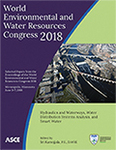World Environmental and Water Resources Congress 2018
A Mechanistic Model for Gas Ebullition in the Presence of NAPLs in Sediments
Publication: World Environmental and Water Resources Congress 2018: Hydraulics and Waterways, Water Distribution Systems Analysis, and Smart Water
ABSTRACT
Gas ebullition (formation of biogenic bubbles in sediment) is a complex interplay of biological, physical, and chemical processes. Research in our lab and by others has demonstrated the importance of gas ebullition in mobilizing sediment pollutants to the water column. In this study we developed a model using fundamental biological, chemical, and geomechanical principles to better understand the simultaneous impact of non-aqueous phase liquids (NAPLs) and methanogenesis on gas ebullition in sediments. Methanogenic gas production was predicted using our previously published dynamic model with sediment organic content, temperature, and sediment mechanical properties as key forcing variables. The model was validated using gelatin as a model elastic material with properties similar to those of cohesive sediment and mineral oil as a model NAPL. Sediment fracture results with gelatin were similar to those in model predictions, and the presence of NAPL was shown to decrease the sediment strength. These simulation and experimental results demonstrate the importance of temperature and NAPL presence in predicting gas ebullition rate.
Get full access to this chapter
View all available purchase options and get full access to this chapter.
ACKNOWLEDGMENT
This research was funded by a grant from ExxonMobil Environmental Services Company.
REFERENCES
Algar, C. and Boudreau, B. (2009). “Transient growth of an isolated bubble in muddy, fine-grained sediments.” Geochimica et Cosmochimica Acta, 73(9), 2581–2591.
Algar, C. and Boudreau, B. (2010). “Stability of bubbles in a linear elastic medium: Implications for bubble growth in marine sediments.” Journal of Geophysical Research: Earth Surface, 115(F3).
Claypool, G. E. and Kaplan, I. R. (1974). The origin and distribution of methane in marine sediments. Springer US, Boston, MA, 99–139.
Demirel, B. and Scherer, P. (2008). “The roles of acetotrophic and hydrogenotrophic methanogens during anaerobic conversion of biomass to methane: A review.” Reviews in Environmental Science and Bio/Technology, 7(2), 173–190.
Fendinger, N. J., Adams, D. D., and Glotfelty, D. E. (1992). “The role of gas ebullition in the transport of organic contaminants from sediments.” Science of the total environment, 112(2–3), 189–201.
Gardiner, B., Boudreau, B., and Johnson, B. (2003). “Growth of disk-shaped bubbles in sediments.” Geochimica et Cosmochimica Acta, 67(8), 1485–1494.
Gross, D. and Seelig, T. (2006). “Micromechanics and homogenization.” Fracture Mechanics: With an Introduction to Micromechanics, 217–287.
Jain, A. and Juanes, R. (2009). “Preferential mode of gas invasion in sediments: Grainscale mechanistic model of coupled multiphase fluid flow and sediment mechanics.” Journal of Geophysical Research: Solid Earth, 114(B8).
Kaliappan, R. and Rockne, K. J. (2015). “Estimating post-capping GW-SW exchange at the Grand Calumet river using streambed temperature profiles.” Eighth International Conference on the Remediation and Management of Contaminated Sediments, New Orleans, LA, 9 pp (January 13–15).
Katsman, R., Ostrovsky, I., and Makovsky, Y. (2013). “Methane bubble growth in fine-grained muddy aquatic sediment: Insight from modeling.” Earth and Planetary Science Letters, 377–378(Supplement C), 336 – 346.
Scandella, B. P., Varadharajan, C., Hemond, H. F., Ruppel, C., and Juanes, R. (2011). “A conduit dilation model of methane venting from lake sediments.” Geophysical Research Letters, 38(6).
Schmid, M., Ostrovsky, I., and McGinnis, D. F. (2017). “Role of gas ebullition in the methane budget of a deep subtropical lake: What can we learn from process-based modeling?.” Limnology and Oceanography, 62(6), 2674–2698.
Takada, A. (1990). “Experimental study on propagation of liquid-filled crack in gelatin: Shape and velocity in hydrostatic stress condition.” Journal of Geophysical Research: Solid Earth, 95(B6), 8471–8481.
Thompson, L. R., Sanders, J. G., McDonald, D., Amir, A., Ladau, J., Locey, K. J., Prill, R. J., Tripathi, A., Gibbons, S. M., Ackermann, G., et al. (2017). “A communal catalogue reveals earths multiscale microbial diversity.” Nature, 551(7681).
Viana, P., Rockne, K. J., Bucaro, D., and Thai, L. (2011). “Sediment gas ebullition and flux studies in the Chicago river.” Proceedings of Sixth International Conference on Remediation of Contaminated Sediments, New Orleans, LA, 8 pp (February 7–10).
Viana, P., Yin, K., and Rockne, K. (2017). “Comparison of direct benthic flux to ebullition-facilitated flux of polycyclic aromatic hydrocarbons and heavy metals measured in the field.” Journal of Soils and Sediments, (17), 1–14. https://doi:10.1007/s11368-017-1893-z
Viana, P., Yin, K., and Rockne, K. J. (2009). “Ebullition-facilitated transport of heavy metal and organic contaminants to the water column.” Proceedings of the Fifth International Conference on Remediation of Contaminated Sediments, Jacksonville, FL, 8 pp.
Viana, P., Yin, K., Zhao, X., and Rockne, K. J. (2007a). “Active sediment capping for pollutant mixtures: Control of biogenic gas production under highly intermittent flows.” Land Contamination and Reclamation, 15(4), 413–425.
Viana, P., Yin, K., Zhao, X., and Rockne, K. J. (2007b). “Modeling and control of gas ebullition in capped sediments.” Proceedings of the Fourth International Conference on Remediation of Contaminated Sediments, Battelle Press, Columbus, OH, 7 pp.
Viana, P. Z. (2012). “Contaminant flux through capped and uncapped sediments.” PhD dissertation, University of Illinois at Chicago.
Viana, P. Z., Yin, K., and Rockne, K. J. (2012). “Field measurements and modeling of ebullition-facilitated flux of heavy metals and polycyclic aromatic hydrocarbons from sediments to the water column.” Environmental Science & Technology, 46(21), 12046–12054.
Winterwerp, J. C. and Van Kesteren, W. G. (2004). Introduction to the physics of cohesive sediment dynamics in the marine environment, Vol. 56. Elsevier.
Information & Authors
Information
Published In
World Environmental and Water Resources Congress 2018: Hydraulics and Waterways, Water Distribution Systems Analysis, and Smart Water
Pages: 109 - 118
Editor: Sri Kamojjala, Las Vegas Valley Water District
ISBN (Online): 978-0-7844-8142-4
Copyright
© 2018 American Society of Civil Engineers.
History
Published online: May 31, 2018
Authors
Metrics & Citations
Metrics
Citations
Download citation
If you have the appropriate software installed, you can download article citation data to the citation manager of your choice. Simply select your manager software from the list below and click Download.
